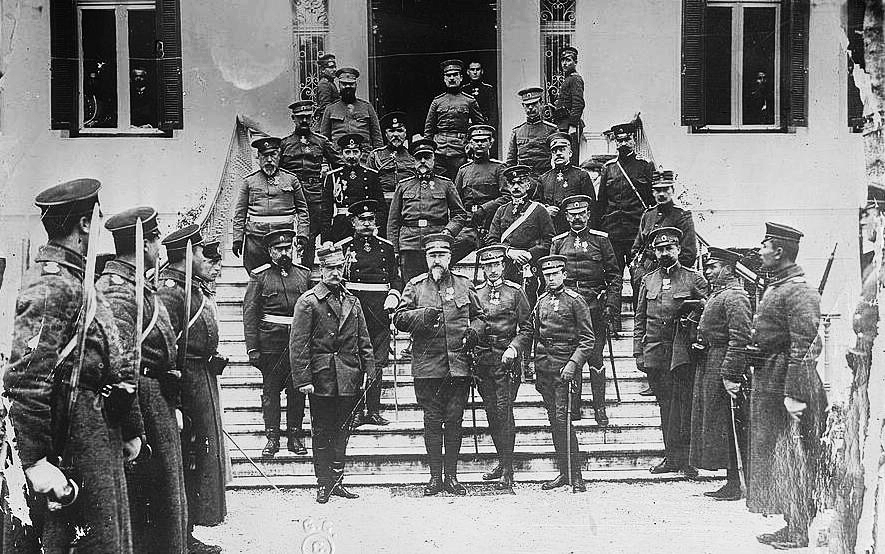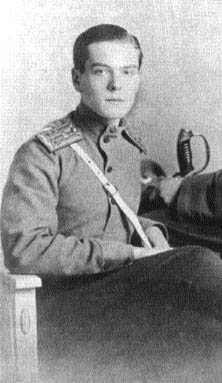The following is taken from Dr. Igor Resnick's 'History of the Oslads: The Terrible War and Beyond'

Tsar Lubomir II Manevski and the Osladian Royal Guard and General Staff, circa 1918.

Tsar Lubomir II Manevski and the Osladian Royal Guard and General Staff, circa 1918.
For decades historians, economists, and political scientists have debated and discussed the series of events leading to the Revolution of 1915 and the Terrible War. Both conflicts changed Osladian culture, politics, and society for decades to come and established a new order in Centra's political hemisphere.
After the death of his father, Nikolas III, Lubomir ascended to the throne in 1883 at the age of 26 years old as 'Lubomir II'. In the early months of his reign it became evident that Lubormir was not like his father, and was indeed opposite in many ways. While Nikolas has gone down as a reformist and 'liberator' with his banning of serfdom in 1863, Lubomir followed a far more traditionalist and conservative line. While his more rightist values had won him points within the military elite and nobility he had grown up around, it won him no favors among the new more independent and reformist lower class. In 1885 councilors and magistrates from the Boletarian ethnic centers protested at the Duma demanding not only representation within the Duma but also more autonomy and the right to establish their own workers unions. However all demands of representation had quickly been shot down by the new Tsar.
In foreign affairs Tsar Lubomir followed closely in the footsteps of his father, the strong Osladian-Survaekom tie being the only thing the two men shared in common. In a visit to the capital of the Grand Empire, Lubomir was stated to have praised the Empire's ability to keep such a broad ethnic spectrum without falling to chaos, and praised the Suravekom for their unity. These words of praise however, did not change his negative outlook upon the Boletarians within his own Empire. Another policy kept by Lubomir was the anti-Soroyan sentiments held by the state and a general resentment towards eastern states, believing they had allowed the 'uneducated rabble' to dominate a nobleman's political world.
Despite Lubomir's faults, the Tsar was also a strong environmentalist. In letters written to his brother, Grand Prince Andrev, Lubomir was prone to stating his jealousy towards his brother over his horseback tour of the Empire. The young Tsar was also known to pay close attention to the palace garden and often would hold entire cabinet meetings in the garden while he tended to the plants, stating that 'the mind worked better among god's creation'. Three months before the end of 1889, at the age of 32, Tsar Lubomir and Queen Vedrana announced the birth of their first son and heir, Grand Prince Anton.

Grand Prince Anton at the age of 26, circa 1915.
For the remainder of the latter years of the 19th century there is little to note on the actions of the Osladian state. However an air of tension had begun to hang over the Duma as Boletarian nationalism continued to see rise and violence in the east had become far more common than in prior years. These tensions came to a head shortly after New Years in January of 1900. After an official increase in tax for non-Osladians Wrenclaw faced protests from angered and subjugated Boletarians, these protests turned to violence shortly after a Osladian soldier retaliated to rocks being thrown by the protesters with gunfire, turning the peaceful protest into an outright riot. Boletarian rioters stormed the Wrenclaw garrison, killing ten Osladian soldiers and declared Wrenclaw a city in revolution. In Oslograde the Tsar had become infuriated with the 'savagery' of the 'Boletarian menace' and dispatched Imperial forces to put Wrenclaw to the sword and restore the peace.

Boletarian men and women turned to outright rebellion against the Osladian Empire, circa 1900.
Despite the enthusiasm and will to resist against Oslad, the defenders of Wrenclaw were not prepared for the wrath of the Empire. The siege of Wrenclaw lasted nearly a month, and in early March of 1900 the city was stormed by Imperial Osladian soldiers. By the end of the siege, over three thousand Boletarians laid dead in the streets of Wrenclaw and countless more injured and imprisoned or executed. The entire revolt would go down in history and the revolters would be remembered as martyrs against an ever increasing authoritarian monarchy.
Outside of the Empire the world was shocked by the brutality of the Imperial Osladian Army, earning the Tsar the title of 'butcher' and the armed forces 'apes' by Soroyans. However Tsar Lubomir stood by his decision and awarded the officers in command of putting down the Wrenclaw Rebellion for their service to the Osladian Empire. After the events in Wrenclaw a larger military force remained permanently stationed in Boletaria in the event of another rebellion during peacetime. However the damage had been done, and the Boletarians had 'learned their place' for the time being.
Incidents of violence did not end in Wrenclaw however. Across the Empire working conditions continued to falter and little had been done to compensate the industrial labourers for their dangerous work. In the agricultural sector farmers working on land they did not own faced equally unfair and brutal conditions, often making only 20-30% of their crop while the landlord took the majority of the yield. However, the largest qualm the everyman of Oslad held with the state was the lack of non-government created unions. This led to many complaints and protestations simply being washed over and swept under the rug, often without any notification being given to the Tsar or his cabinet of the complaints to begin with. Thus, illegal and underground unions began to organize and communicate with one another. This act of subtle resistance to the ridiculous labour conditions of the state began a war of espionage between the underground unions and the secret police of the Osladian state.
Since the days of Nikolas III the Department of State Secrets and Security (DSSS) had existed as an unmentioned department of the government, known only by the higher echelons of the state. A 'black budget' had been created specifically to manage the funding of this department and continue leaving the DSSS as a myth. Since the beginning of Tsar Lubomir's reign the department had grown extensively and secret offices had been established in Boletaria to oversee subversive actions against any underground organizations and circles of resistance. The department saw it's height in the years building up to the Terrible War, when socialists and unionists were at peak influence in the industrial sector of the Osladian Empire. During these turbulent years a cold war was fought between the two groups and infiltrator hunting had become an art.

Members of the Department of State Secrets and Security, circa 1905
The true origins of the Terrible War can be found in 1914, a year prior to the second revolution in Boletaria and the uprising in Novouvodsk that sparked the Osladian Civil War. In the summer of 1914 Grand Prince Andrev wrote a letter to Tsar Lubomir urging his brother to abdicate and allow Grand Prince Anton to ascend to the throne. Tsar Lubomir was now an aging man and with each passing year his beliefs and outlook became more outdated. Needless to say, the Tsar was outraged. He had loved his son, but his son was only in his twenties and had taken to liberalism like many of the young nobility had at the time. In a fiery letter Lubomir cursed his brother for being a 'fool' who had become idealistic like their father. From that point until his death in 1919 Lubomir and Andrev had minimal contact and the two had begun to resent each other.
Only 9 months later in March of 1915 would a second revolt spark in Boletaria. This time the revolts came prepared, supplied with arms from outside agents, and took Wrenclaw by force. While the bulk of the armed forces marched to fight the sudden Boletarian secessionists, communists took Novouvodsk and declared 'The Osladian Socialist Federation' with insurrectionist sailors taking the regional manor and forming a 'red militia'. In the following months Survaek would come to the aid of the Osladian Empire while Soroya would lay claim to the Boletarian cause, sparking what we know today as the Terrible War.

Red Militiamen tossing a portrait of Tsar Nikolas III onto a fire in Novouvodsk, painting by Sergei Lavostok.
In the next chapter we shall discuss the precarious situation the Osladian Empire faced in the early days of the Civil War and the Terrible War as well as the death of Tsar Lubomir, the military council that followed, and the ascension of Tsar Anton Manshevski I to the throne in late 1919.




